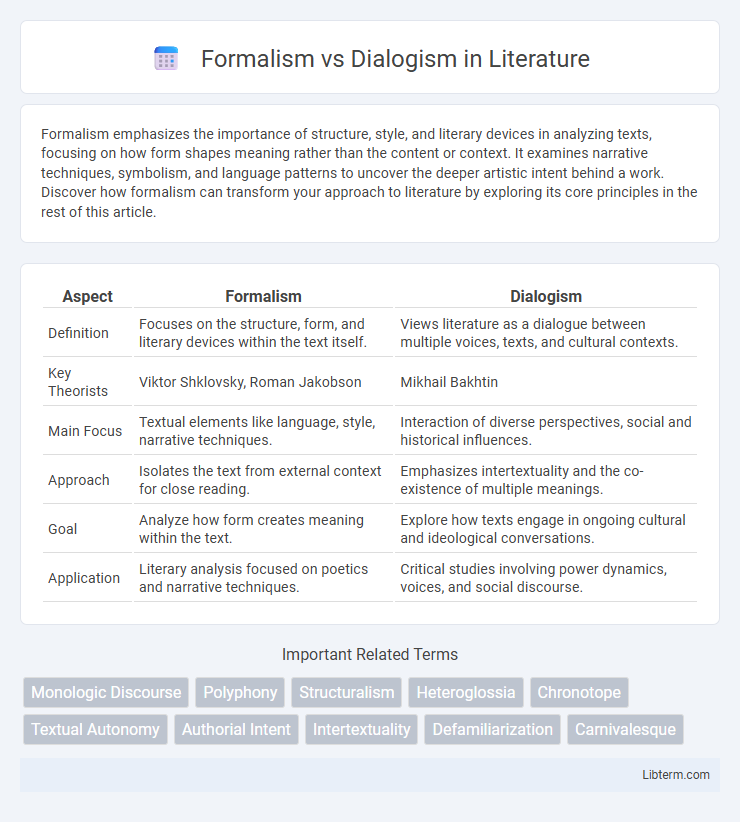Formalism emphasizes the importance of structure, style, and literary devices in analyzing texts, focusing on how form shapes meaning rather than the content or context. It examines narrative techniques, symbolism, and language patterns to uncover the deeper artistic intent behind a work. Discover how formalism can transform your approach to literature by exploring its core principles in the rest of this article.
Table of Comparison
| Aspect | Formalism | Dialogism |
|---|---|---|
| Definition | Focuses on the structure, form, and literary devices within the text itself. | Views literature as a dialogue between multiple voices, texts, and cultural contexts. |
| Key Theorists | Viktor Shklovsky, Roman Jakobson | Mikhail Bakhtin |
| Main Focus | Textual elements like language, style, narrative techniques. | Interaction of diverse perspectives, social and historical influences. |
| Approach | Isolates the text from external context for close reading. | Emphasizes intertextuality and the co-existence of multiple meanings. |
| Goal | Analyze how form creates meaning within the text. | Explore how texts engage in ongoing cultural and ideological conversations. |
| Application | Literary analysis focused on poetics and narrative techniques. | Critical studies involving power dynamics, voices, and social discourse. |
Introduction to Formalism and Dialogism
Formalism, rooted in early 20th-century literary theory, emphasizes the structural elements of texts, such as syntax, imagery, and narrative techniques, viewing literature as an autonomous artistic object. Dialogism, developed by Mikhail Bakhtin, highlights the interactive nature of language, stressing the importance of multiple voices, social context, and the dynamic interplay between author, text, and reader. While formalism isolates the text's inherent features, dialogism situates meaning within ongoing cultural and social dialogues.
Historical Context and Development
Formalism emerged in early 20th-century Russia as a reaction against the didactic and historical approaches to literature, emphasizing intrinsic literary devices and structures. Dialogism, introduced by Mikhail Bakhtin mid-20th century, centers on the interaction of multiple voices and perspectives within a text, reflecting social and historical contexts. The development of these theories highlights a shift from analyzing isolated linguistic elements to exploring dynamic intertextual and cultural dialogues in literary works.
Core Principles of Formalism
Formalism centers on analyzing literary works through their intrinsic features such as structure, language, and narrative techniques, emphasizing the autonomy of the text. It prioritizes elements like rhyme, meter, syntax, and literary devices to understand meaning independently from historical or social contexts. Core principles include close reading, the idea of "defamiliarization" to make the familiar appear strange, and treating literature as a self-contained system.
Key Concepts of Dialogism
Dialogism centers on the interaction of multiple voices, emphasizing heteroglossia and the dynamic interplay of perspectives within a text. Unlike Formalism, which prioritizes the autonomous structure and form of the literary work, dialogism highlights polyphony, where diverse social languages and consciousness coexist and contest meanings. This theory, developed by Mikhail Bakhtin, views meaning as fluid and constructed through ongoing dialogue between texts, authors, and readers.
Major Proponents and Influences
Formalism, championed by Viktor Shklovsky and Roman Jakobson, emphasizes the intrinsic features of texts such as structure, form, and literary devices, laying the groundwork for structuralist approaches in literary theory. Dialogism, rooted in the work of Mikhail Bakhtin, highlights the interactive nature of language and meaning through the concept of dialogue among voices, influencing post-structuralism and contemporary narrative studies. Both theories significantly shaped 20th-century literary criticism by contrasting the autonomy of the text with the dynamic interaction of multiple perspectives.
Literary Text Analysis: Formalist Approach
The Formalist approach in literary text analysis emphasizes the intrinsic features of the text, such as structure, language, and literary devices, isolating the work from historical or social contexts. This method prioritizes close reading to uncover how narrative techniques and form contribute to the overall meaning and aesthetic experience. Formalism contrasts with Dialogism by focusing on the text itself rather than the multiplicity of voices or external influences interacting within the work.
Literary Text Analysis: Dialogic Approach
The dialogic approach to literary text analysis emphasizes the interaction of multiple voices, perspectives, and meanings within a text, rejecting the fixed, singular interpretation favored by Formalism. It explores how texts engage in ongoing conversations with other texts, cultural contexts, and reader responses, highlighting heteroglossia and polyphony as key concepts introduced by Mikhail Bakhtin. This method reveals the dynamic, socially embedded nature of literature, contrasting with Formalism's focus on intrinsic structural features like syntax, narrative techniques, and linguistic devices.
Comparative Strengths and Limitations
Formalism excels in analyzing structural elements, emphasizing narrative techniques, language, and form, which allows for detailed textual interpretation. Dialogism offers strengths in exploring intertextuality and the multiplicity of voices, providing insight into the dynamic social and cultural interactions within texts. Limitations of Formalism include its neglect of historical and social contexts, while Dialogism may sometimes lack focus on the intrinsic structures that shape meaning.
Contemporary Relevance in Literary Theory
Formalism emphasizes close reading and intrinsic textual features, maintaining relevance in contemporary literary analysis through its rigorous focus on structure, language, and form. Dialogism, introduced by Mikhail Bakhtin, remains vital in exploring the multiplicity of voices, socio-cultural context, and intertextuality within texts, fostering dynamic interpretations. Current literary theory integrates both approaches to balance textual autonomy with contextual plurality, enhancing critical depth and interpretive diversity.
Conclusion: Synthesizing Formalism and Dialogism
Formalism emphasizes the autonomous structure and intrinsic features of a text, while Dialogism highlights the interactive, dynamic interplay of multiple voices and perspectives within literature. Synthesizing these approaches reveals that texts possess inherent formal qualities shaped and enriched by dialogic relationships, enabling a more comprehensive interpretation that accounts for both internal coherence and intertextual dialogue. Integrating formal analysis with dialogic context enhances literary criticism by balancing structural integrity with the fluidity of cultural and ideological exchanges.
Formalism Infographic

 libterm.com
libterm.com